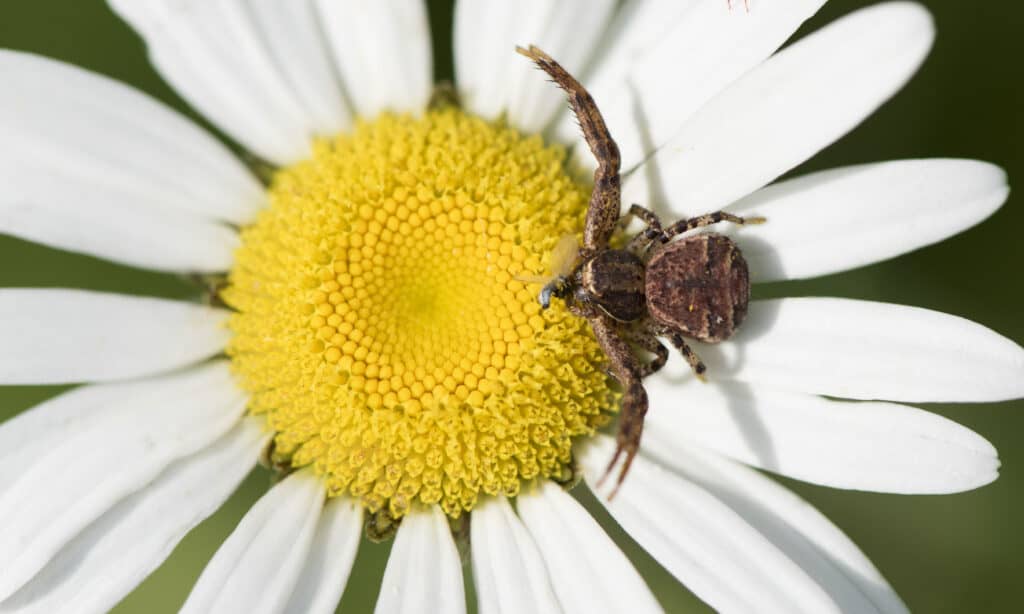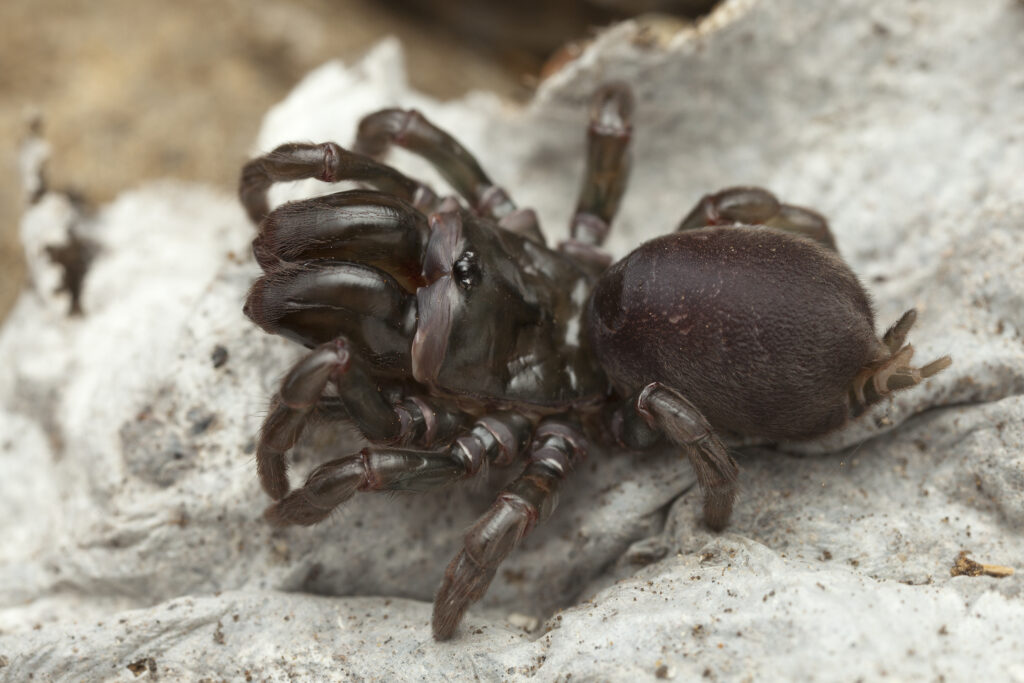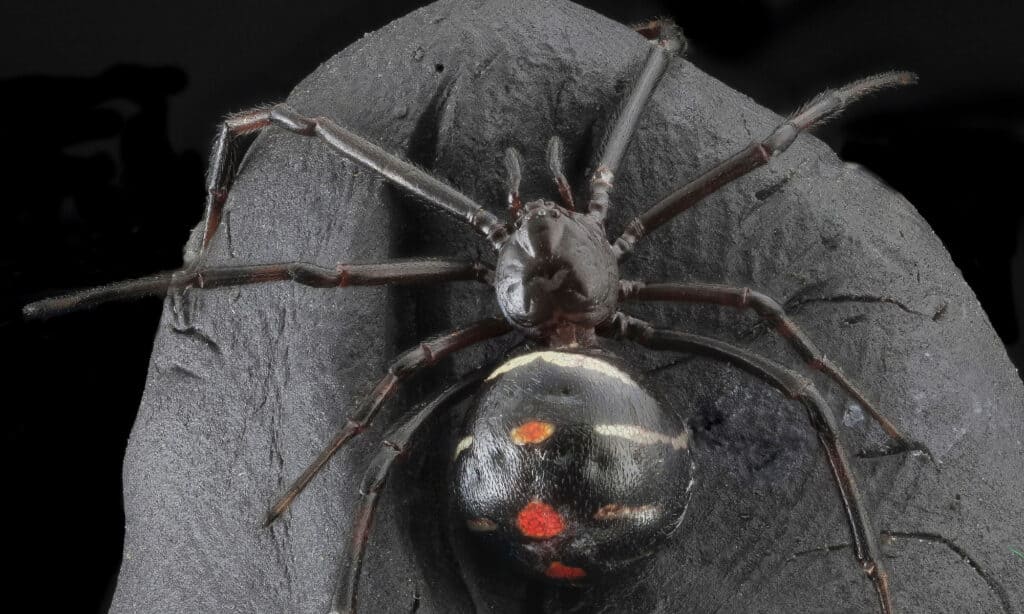Illinois is a state of great diversity, from the bustling city streets of Chicago to the tranquil countryside. But beneath the surface lies a world that is often overlooked, where creatures thrive in the shadows and go unnoticed. Among them are the black spiders of Illinois, a group of predators that are ominous to many.
Let us take a closer look at some of the fascinating black spiders that call Illinois home.
1. Black Lace-Weaver Spider (Amaurobius ferox)

©Wildsmith_Westwood/Shutterstock.com
Female black lace-weavers range in size from 0.4 to 0.6 inches, while males are slightly smaller at 0.3 to 0.4 inches. Their color palette includes black, brown, dark red, and tan tones, with distinctive light-yellow markings on their abdomen. These marks resemble a ghoulish pattern or eerie skull mask.
During the late summer and autumn months, males venture out in search of prospective female partners. These males typically enter the female’s web and spin special silk threads in an attempt to attract the female.
Black lace-weavers are often found near man-made structures and prefer dark areas. During the spring, adult males tend to wander indoors searching for mates. Additionally, adult females can be found indoors and outdoors throughout the year.
These spiders play a crucial role in the ecosystem as they act as predators of various insects and other invertebrates. By controlling the population of these species, black lace-weavers contribute to maintaining the delicate balance.
Black lace-weavers are not known to be aggressive toward humans. However, there have been a few documented cases of their bites. These bites can be painful, but the symptoms are usually limited to localized swelling that subsides within 12 hours.
Fun Facts About Black Lace-Weaver Spiders
- The young spiderlings of the black lace-weaver engage in cannibalism by consuming their mother.
- This species is known for creating intricate cribellate webs to capture prey.
- Females have a lifespan of two years, whereas males only live for a few months.
2. Bark Crab Spider (Bassaniana versicolor)

©Brandt Bolding/Shutterstock.com
Bark crab spiders, or Bassaniana versicolor, have a black or brown coloration with white spots. They are referred to as crab spiders due to their crablike appearance. Females grow up to 0.266 inches long, while males are slightly smaller, ranging between 0.15 to 0.18 inches. Their abdomen is flat and wide.
These predatory spiders hunt actively without relying on webs to capture prey. Instead, they primarily use spider silk for courtship purposes, where males decorate females with silk strands.
The hunting ground of bark crab spiders encompasses various locations. They like woods, forests, and parks, with a preference for tree bark. However, they are also found on short plants, forest floors, and beneath stones and dead wood.
Bark crab spiders are known for their varied diet, which includes numerous insects, like worker ants. These spiders are exceptional hunters, relying on their quick reflexes and superior skills to capture their meals with ease. Despite their small size, they are a force to be reckoned with in the world of predators!
They possess potent venom that can subdue prey much larger than them. However, their venom is not harmful to humans, as their bites are generally unable to penetrate the skin.
Fun Facts About Bark Crab Spiders
- There are over 2,100 species of crab spiders worldwide.
- Female bark crab spiders often cannibalize their male mating partners.
- Bark crab spiders use their front two legs to kill by strangling prey.
3. Bold Jumping Spider (Phidippus audax)

©Mircea Costina/Shutterstock.com
The bold jumping spider has a round cephalothorax and an ovoid abdomen and is usually black in color. The species can be easily recognized by the presence of a white triangle in the center of the back. It also has two smaller spots beneath it, which serve as a distinctive characteristic. Additionally, a white lateral band can be seen on the upper abdomen. The male typically measures about 0.126 inches, while the female is larger, measuring around 0.16 inches.
Phidippus audax possesses vision that is even more acute than that of a cat. The spider’s exceptional eyesight is utilized for locating prey and competitors and finding and courting potential mates.
Bold jumping spiders primarily feed on other spiders, non-aquatic arthropods, and insects. These spiders tend to hunt during the daytime and avoid going out at night. To catch a meal, they sneak up and jump, then paralyze their prey with venom.
If threatened or mishandled, bold jumping spiders may bite humans, although such occurrences are infrequent. The bites are generally considered harmless and are typically characterized as mildly painful.
Fun Facts About Bold Jumping Spiders
- Bold jumping spiders may fall prey to lizards, dragonflies, birds, and other spider species.
- During the night, bold jumpers can take refuge in sac-like silk retreats near their hunting areas.
- They have a lifespan of over one year, with females surviving a few months longer than males.
4. Black Purseweb Spider (Sphodros niger)

©Pavel Krasensky/Shutterstock.com
The black purseweb spider boasts a shiny black exterior, with the exception of a gray or pale bluish stripe that runs across its head at the base of the chelicerae. The size of the black purseweb spider’s body can vary, with lengths ranging from 0.4 to 1.5 inches. Female spiders of this species are generally larger.
The black purseweb spider spends much of its time concealed within its tubelike web, patiently waiting for prey. This behavior means spotting these spiders in the wild is rare. If someone does happen to come across a purseweb spider, it’s typically a male wandering in search of a mate.
The black purseweb spider can be found inhabiting damp woodlands and, occasionally, swamps or open woods in temperate, tropical climates.
Predation is a natural behavior of the black purseweb, which preys on insects, smaller spiders, and other similar creatures.
Similar to other spider species, the black purseweb has venom that it uses to immobilize its prey. They can bite humans if handled carelessly. However, their bites are generally not a threat to humans, except in the case of extreme sensitivity to spider venom.
Fun Facts About Black Purseweb Spiders
- The black purseweb spider weaves a cylindrical tube and resides inside it for most of its life.
- Young purseweb spiders shed their skin as a part of their growth process.
- These spiders are not considered pests and are seldom encountered by humans.
5. Northern Black Widow Spider (Latrodectus variolus)

©Porco_Rosso/Shutterstock.com
Illinois is home to a wide variety of spider species, with over 500 known to inhabit the area. However, people only see a small portion of these spiders, approximately 30 to 35. Among these common species is the northern black widow, a spider notorious for its venomous bite.
The divided hourglass pattern on the underside of the abdomen is a distinguishing feature of the northern black widow spider. In addition, these spiders have a distinct line of red spots along the middle of their back and several white stripes running parallel to their sides. Males are generally smaller than their female counterparts, measuring less than 1-1.5 inches long.
Insects and male black widow spiders are the most vulnerable to the black widow’s venomous bite. In fact, females kill and eat the male after mating, which is where this spider gets its name.
These spiders tend to seek out dark and isolated areas, such as crevices and woodpiles, as their preferred habitat. When they enter human dwellings, they typically hide in sheltered and dimly lit spots.
Using their webs as traps, black widow spiders catch various types of prey, such as flies, mosquitoes, beetles, caterpillars, and grasshoppers.
When northern black widow spiders bite humans, it can cause muscle aches, nausea, and even paralysis of the diaphragm, making breathing difficult. Although some believe that black widow bites can be deadly, most bites do not cause serious harm, let alone death. However, it is possible for bites to be fatal, especially to vulnerable populations such as small children and the elderly.
Fun Facts About Northern Black Widow Spiders
- With the exception of the violent mating ritual, northern black widow spiders lead a solitary lifestyle.
- The venom of a northern black widow spider is around 15 times stronger than that of a rattlesnake.
- Females construct large webs that contain a cocoon with hundreds of eggs.
6. Southern Black Widow Spider (Latrodectus Mactans)

©Jeff W. Jarrett/Shutterstock.com
Females of the southern black widow species are easily identifiable by their shiny black appearance and a red hourglass marking on their abdomen. This hourglass is complete, unlike the northern widow’s, which may have an incomplete or even missing hourglass. In contrast, male southern black widows do not possess this distinctive feature but may instead display red spots on the top or underside of their abdominal segment.
The average length of the female’s body is approximately 3/8 inch, while the male’s body is smaller, measuring about 3/16 inch in length.
Like many other spider species, the southern black widow creates strong silk to construct webs to capture prey. However, black widow spiders design their webs without a discernible pattern and construct them in an unpredictable, erratic manner.
These spiders commonly inhabit various outdoor areas, such as rodent burrows, hollow tree stumps, and wood and rock piles. Meanwhile, indoor environments, like outhouses, sheds, basements, and garages, can also serve as suitable habitats for these spiders.
Southern black widows feed on a diverse array of insects, though they show a particular preference for fire ants when available. During their youth, they consume woodlice, diplopods, and chilopods, along with other arachnids on occasion.
The venom produced by this spider can have varying effects on different individuals’ nervous systems. While some may only experience mild symptoms, others may suffer from severe reactions. Upon being bitten, immediate symptoms may include intense pain, swelling, burning sensations, redness, and visible puncture wounds caused by the spider’s fangs.
Fun Facts About Southern Black Widow Spiders
- The spider’s web is capable of ensnaring animals as large as mice.
- Black widows are useful in managing pest populations.
- The southern black widow’s lifespan averages 1.5 years, while the male lives just two to five months.
The post Discover 6 Black Spiders in Illinois appeared first on AZ Animals.
from Animal News, Facts, Rankings, and More! - AZ Animals https://ift.tt/T4CyKNm